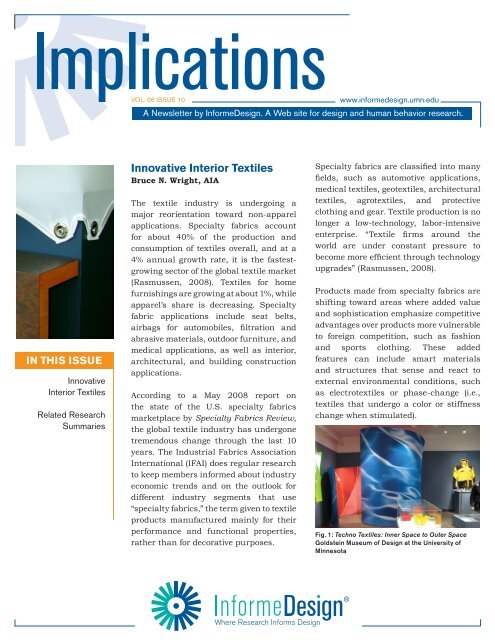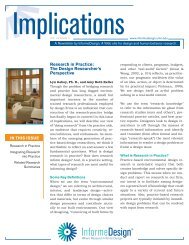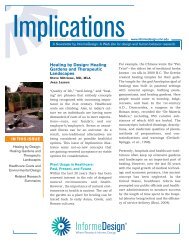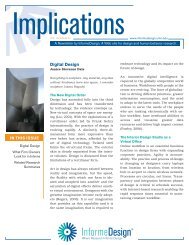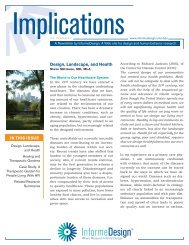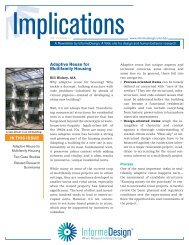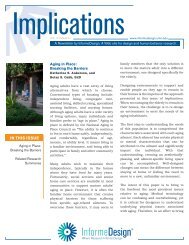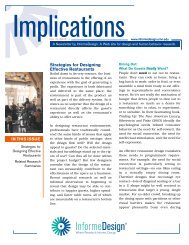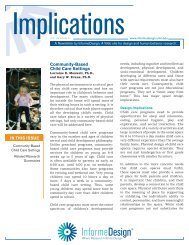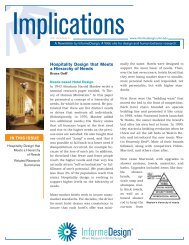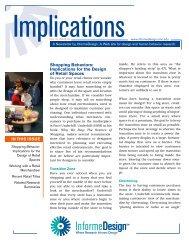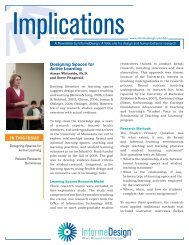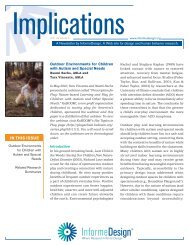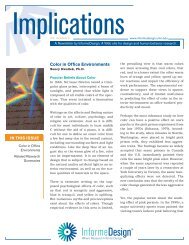Innovative Interior Textiles: Vol. 6, Issue 10 - InformeDesign
Innovative Interior Textiles: Vol. 6, Issue 10 - InformeDesign
Innovative Interior Textiles: Vol. 6, Issue 10 - InformeDesign
You also want an ePaper? Increase the reach of your titles
YUMPU automatically turns print PDFs into web optimized ePapers that Google loves.
Implications<br />
VOL. 06 ISSUE <strong>10</strong><br />
www.informedesign.umn.edu<br />
A Newsletter by <strong>InformeDesign</strong>. A Web site for design and human behavior research.<br />
IN THIS ISSUE<br />
<strong>Innovative</strong><br />
<strong>Interior</strong> <strong>Textiles</strong><br />
Related Research<br />
Summaries<br />
<strong>Innovative</strong> <strong>Interior</strong> <strong>Textiles</strong><br />
Bruce N. Wright, AIA<br />
The textile industry is undergoing a<br />
major reorientation toward non-apparel<br />
applications. Specialty fabrics account<br />
for about 40% of the production and<br />
consumption of textiles overall, and at a<br />
4% annual growth rate, it is the fastestgrowing<br />
sector of the global textile market<br />
(Rasmussen, 2008). <strong>Textiles</strong> for home<br />
furnishings are growing at about 1%, while<br />
apparel’s share is decreasing. Specialty<br />
fabric applications include seat belts,<br />
airbags for automobiles, filtration and<br />
abrasive materials, outdoor furniture, and<br />
medical applications, as well as interior,<br />
architectural, and building construction<br />
applications.<br />
According to a May 2008 report on<br />
the state of the U.S. specialty fabrics<br />
marketplace by Specialty Fabrics Review,<br />
the global textile industry has undergone<br />
tremendous change through the last <strong>10</strong><br />
years. The Industrial Fabrics Association<br />
International (IFAI) does regular research<br />
to keep members informed about industry<br />
economic trends and on the outlook for<br />
different industry segments that use<br />
“specialty fabrics,” the term given to textile<br />
products manufactured mainly for their<br />
performance and functional properties,<br />
rather than for decorative purposes.<br />
Specialty fabrics are classified into many<br />
fields, such as automotive applications,<br />
medical textiles, geotextiles, architectural<br />
textiles, agrotextiles, and protective<br />
clothing and gear. Textile production is no<br />
longer a low-technology, labor-intensive<br />
enterprise. “Textile firms around the<br />
world are under constant pressure to<br />
become more efficient through technology<br />
upgrades” (Rasmussen, 2008).<br />
Products made from specialty fabrics are<br />
shifting toward areas where added value<br />
and sophistication emphasize competitive<br />
advantages over products more vulnerable<br />
to foreign competition, such as fashion<br />
and sports clothing. These added<br />
features can include smart materials<br />
and structures that sense and react to<br />
external environmental conditions, such<br />
as electrotextiles or phase-change (i.e.,<br />
textiles that undergo a color or stiffness<br />
change when stimulated).<br />
Fig. 1: Techno <strong>Textiles</strong>: Inner Space to Outer Space<br />
Goldstein Museum of Design at the University of<br />
Minnesota
Implications<br />
www.informedesign.umn.edu<br />
2<br />
Other new innovations involve nanotechnologies (i.e.,<br />
manipulating material properties at the molecular<br />
level to produce enhanced performance qualities)<br />
that have created new products such as textiles<br />
that detect chemicals and gases, generate mobile<br />
power, and incorporate flexible sensing systems.<br />
Moreover, research is ongoing to develop fabrics<br />
that can reliably carry data and power, which could<br />
open a whole new area of product applications in the<br />
building and interiors markets. The global market for<br />
nanomaterials is expected to reach $4.2 billion by<br />
2011.<br />
Fig. 2: National Aquatic Center, Australia, clad in a bubble wrap made<br />
of ethylene tetra flouro ethylene (ETFE) foil pillows.<br />
Unique <strong>Interior</strong>s Applications<br />
There are five areas where specialty fabrics contribute<br />
to innovations in interiors. New ideas and innovations<br />
are now seen in textile walls, fabric ceilings with<br />
unique properties, integrated fabric lighting, and<br />
unique furniture designs. Equally important, is the<br />
trend of applying outdoor fabrics, such as awning<br />
fabrics or marine cover and seating fabrics indoors.<br />
These high durability fabrics (also called performance<br />
fabrics) are woven like indoor fabrics, with finishing<br />
techniques that create softness for easy draping,<br />
in contrast to the stiff, canvas-like qualities of<br />
traditional outdoor fabrics. Performance fabrics are<br />
selected when requirements call for fade, moisture,<br />
and stain resistance, as well as ease of cleaning.<br />
High-end furniture makers and upholsterers are<br />
requesting performance fabrics more often.<br />
Driving the demand for performance fabrics is the<br />
residential design trend focusing on outdoor living<br />
spaces. Furniture is frequently moved in and out,<br />
and the distinction between spaces is blurred. Fade<br />
resistance is a major selling point of performance<br />
fabrics in states like California and Florida. Ultraviolet<br />
(UV) rays pass through transparent walls (i.e., glass<br />
windows) and open floor plans bring in large amounts<br />
of daylight. Concurrent with the push to outdoor<br />
living is the demand for more textured fabrics for<br />
use on exterior-bound furniture, such as jacquards,<br />
medallion weaves, and dobby textures. Fabrics of<br />
these types cost between $<strong>10</strong>0 to $200 a yard, and<br />
are very durable. “Texture is very big right now,<br />
whether created by weaving techniques or through<br />
use of novelty yarns” (Kleinschmidt, 2008).<br />
Textile Walls<br />
Developments in the application of specialty fabrics<br />
include the application of textiles as interior walls.<br />
Unlike standard wall coverings found in typical office<br />
developments, these textiles have structural qualities.<br />
Tensile fabric structures used for interior walls are<br />
constructed for long-term use. These fabric walls need<br />
to be torqued (like the twist of a propeller blade) to<br />
introduce stiffness to the warp and weft of the fabric<br />
weave. Torqued fabrics minimize flutter and prevent<br />
loose sheets of fabric that could lead to ripped fabric<br />
if left unattended. The construction of these textile<br />
walls is accomplished by the introduction of double<br />
curvature or the “anticlastic” (i.e., surfaces have<br />
double curvature in diametrically opposite directions,<br />
like a saddle.), curving of fabric in two directions at<br />
every point on the surface of the fabric.<br />
Think of a saddle shape: in one direction (x axis)<br />
the form curves upward or outward, in the opposite<br />
Where Research Informs Design®
Implications<br />
www.informedesign.umn.edu<br />
3<br />
direction (y axis) the surface curves downward or<br />
inward. This is done by undulating the top edge of the<br />
fabric wall in counterpoint to an undulating bottom<br />
edge. If the top edge bulges out, its corresponding<br />
bottom edge curves in, and so on down the line. The<br />
result is a wall that has dynamic visual energy, and<br />
is unmatched by any flat wall covering no matter how<br />
bright the color pigment.<br />
One striking example of these textile interior walls can<br />
be found at a corporate restaurant in the Leavesden<br />
offices of British Telecom. Architects from Building<br />
Design Partnership (BDP) in London, designed a<br />
“soft screen” fabric wall to separate the staff kitchen<br />
and serving space from the table seating area. BDP<br />
stretched a PVC-coated fine-mesh screen between two<br />
sinuous, horizontal, aluminum rails. With dramatic<br />
down lighting, the wall takes on a theatrical quality<br />
that energizes the space. When the mesh screen is<br />
backlit, it becomes translucent, and when it is lit from<br />
the front, it becomes opaque.<br />
Fig. 3: Corporate restaurant in British Telecom office building used<br />
“soft screen” fabric to separate the kitchen from seating area.<br />
Fabric Ceilings<br />
Fabric ceilings have a history that goes back to<br />
prehistoric times to the invention of tent structures as<br />
dwelling. New within the last four to five years is the<br />
availability of practical and efficient high performance<br />
fabrics offered in wide widths of stretched fabric<br />
panels. These innovative ceiling applications come<br />
from Europe, where most of the research and<br />
development of stretched fabric ceilings is ongoing.<br />
Fire retardant, flame-resistant fabrics are hung via<br />
various methods of fastening. Some fabric is hung<br />
with tension springs around the perimeter to ensure<br />
taut, flat surfaces, and others are hung with custom<br />
aluminum extrusion profiles that provide secure<br />
fittings.<br />
Depending on the tightness of the weave, fabric<br />
ceilings have some advantages over more rigid,<br />
panelized ceiling systems. Large areas can be<br />
covered with fewer attachments to the structure<br />
than rigid systems, saving labor and installation<br />
time. With an open weave fabric light fixtures can<br />
be simple, lowering cost. With lighting hidden above<br />
the fabric plane the fabric’s surface is illuminated,<br />
making the entire ceiling a light source. Changing<br />
the color or fabric texture is simply a matter of unclipping<br />
the mounts and re-stretching a new fabric.<br />
If code requires exposed sprinkler heads, French<br />
manufacturer Chénel makes a special heat-sensitive<br />
fabric ceiling that pulls open along regularly spaced<br />
“melting lines” when a certain temperature is reached,<br />
exposing the sprinkler system, thus preventing major<br />
damage to ceiling, system, and building.<br />
Integrated Fabric Lighting<br />
The market for fabric, lighting, and fixtures is still<br />
largely underdeveloped. Perhaps the most sculptural<br />
of interior applications, applying fabric for lighting,<br />
can take any shape and adapt to many uses including<br />
ceiling mounted fixtures, pendants, wall sconces, or<br />
entire ceilings. Recent designs have favored forms that<br />
exploit the qualities of stretched fabrics over ribs or<br />
tent-like shapes. The light source is contained within,<br />
and the sculptural form glows with diffused light.<br />
There are relatively few manufacturers who specialize<br />
in this genre, and some lighting manufacturers<br />
Where Research Informs Design®
Implications<br />
www.informedesign.umn.edu<br />
4<br />
carry one or two fixtures<br />
that feature textiles in<br />
their line. With an everincreasing<br />
number of<br />
suitable textiles available,<br />
designers can explore new<br />
and innovative ways to<br />
customize fabric lighting,<br />
limited only by their<br />
imagination.<br />
Unique Furniture<br />
Throughout history, there<br />
have been numerous<br />
applications of fabric<br />
to furniture designs,<br />
Fig. 4: Sconce by Studio Lilica<br />
but recent innovations<br />
in fabrics are opening up new uses and new forms<br />
for furniture designers. An example would be high<br />
durability textiles for indoor/outdoor applications<br />
where extra strength in coatings or abrasion resistance<br />
qualities are the most common. As mentioned earlier,<br />
stain, moisture, and fade resistance qualities can<br />
now be designed into the fibers of the textiles for<br />
producing longer, more durable fabrics to be used in<br />
multiple installations.<br />
An exciting area of development is the use of threedimensional<br />
weave or “spacer” fabrics. These<br />
specialty fabrics are woven or knitted with an<br />
unusual thickness (anywhere from a quarter of an<br />
inch to two inches thick). Designed originally for<br />
industrial applications, such as insulating blankets<br />
for manufacturing equipment or highly-specialized,<br />
outer space instrumentation, the potential for these<br />
spacer fabrics is diverse. Some designers are adapting<br />
it for use in furniture backing or to give form to<br />
finished products. An example was presented in a<br />
recent exhibition at the Goldstein Museum of Design,<br />
“Techno <strong>Textiles</strong>: From Inner Space to Outer Space,”<br />
with the design of the Chair of Tomorrow by the late<br />
architect Ralph Rapson. A 3-D spacer fabric<br />
Fig. 5: Ralph Rapson’s Chair of Tomorrow will be fabricated using a 3D<br />
spacer fabric (samples of which are shown at left).<br />
made rigid to form the main shape of the chair was<br />
proposed by Rapson.<br />
New Materials<br />
The potential for specialty fabrics to inform design<br />
decisions is open ended and growing as new textiles<br />
and textile properties are invented. Many new<br />
materials are still in the product development stage<br />
and will soon find their way into design solutions.<br />
Soon we will see phase-change textiles that respond<br />
to stimuli in the environment, impact-resistant<br />
textiles, light emitting fabrics, and data carrying<br />
textiles. As with many of these technologies and<br />
developments, initial product development begins<br />
in different fields such as military or industrial<br />
markets, and is discovered and adapted by designers.<br />
The development of new material research is exciting.<br />
The potential for specialty fabrics to inform design<br />
decisions is limitless and growing as new textiles and<br />
textile properties are invented.<br />
References<br />
—Kleinschmidt, J. (2008, September). The ins and<br />
outs of fabric, Specialty Fabrics Review, 34.<br />
Where Research Informs Design®
Implications<br />
www.informedesign.umn.edu<br />
5<br />
—Rasmussen, J. (2008, May). State of the industry<br />
2008, Part I. Specialty Fabrics Review, 28–35.<br />
Additional Resources<br />
www.3tex.com<br />
www.chenel.com<br />
www.crosslinkusa.com<br />
www.dazian.com<br />
www.fabricarchitecture.info<br />
www.ferrari-textiles.com<br />
www.outdura.com<br />
www.studiolilica.com<br />
www.sunbrella.com<br />
www.transformit.com<br />
About the Author<br />
Bruce N. Wright, AIA, is an<br />
architect, design historian,<br />
writer, and editor of the<br />
international design journal<br />
Fabric Architecture. He is the<br />
co-author of Ralph Rapson:<br />
Sixty Years of Modern Design<br />
(Afton Historical Society<br />
Press, 1999). Wright was<br />
also executive producer of the DVD “Ralph Rapson:<br />
A Modernist Vision” (1999), produced for the joint<br />
exhibitions of Rapson’s work at the Minneapolis<br />
Institute of Arts and the Weisman Art Museum<br />
at the University of Minnesota. He was recently<br />
acknowledged by the Minneapolis College of Art &<br />
Design/Walker Art Center for his book Peter Seitz:<br />
Designing a Life.<br />
Related Research Summaries<br />
<strong>InformeDesign</strong> has many Research Summaries<br />
about interior textiles and textile performance, and<br />
other, pertinent, related topics. This knowledge will<br />
be valuable to you as you consider your next design<br />
solution and is worth sharing with your clients and<br />
collaborators.<br />
“Recycled Fabrics for Sound Absorption”<br />
—Textile Research Journal<br />
“Images Aid the Design Process”<br />
—Journal of Architectural and Planning Research<br />
“Colors Evoke Similar Emotions Internationally”<br />
—Color Research and Application<br />
“<strong>Interior</strong> Designers and Artists Collaborate”<br />
—Housing and Society<br />
“Ceiling and Window Lighting Combinations”<br />
—Journal of Light & Visual Environment<br />
“Quantifying Changes That Improve Fabric Hand”<br />
—Textile Research Journal<br />
Images Courtesy of:<br />
Banner Creations/LEAD Inc. (Main Page)<br />
Goldstein Museum of Design, University of Minnesota<br />
(Fig. 1, 4, & 5)<br />
PTW Architects, Australia (Fig. 2)<br />
Industrial Fabrics Association International (Fig. 3)<br />
The Mission<br />
The Mission of <strong>InformeDesign</strong> is to facilitate designers’<br />
use of current, research-based information as a decisionmaking<br />
tool in the design process, thereby<br />
integrating research and practice.<br />
Creator:<br />
Founding Sponsor:<br />
© 2002, 2005 by the Regents of the University of Minnesota.


